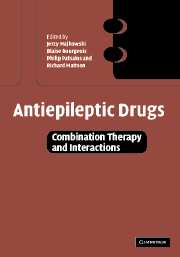Book contents
- Frontmatter
- Contents
- List of contributors
- Foreword
- Foreword
- Acknowledgements
- Part I Introduction
- Part II Pharmacokinetic interactions
- Part III Pharmacodynamic interactions
- 9 Pharmacodynamic principles and mechanisms of drug interactions
- 10 Methods for assessing pharmacodynamic interactions
- 11 Experimental studies of pharmacodynamic interactions
- 12 Clinical studies of pharmacodynamic interactions
- 13 Clinical studies of pharmacodynamic interactions between antiepileptic drugs and other drugs
- Part IV Drug interactions in specific patient populations and special conditions
- Part V Conclusions and future perspectives
- Index
9 - Pharmacodynamic principles and mechanisms of drug interactions
from Part III - Pharmacodynamic interactions
Published online by Cambridge University Press: 07 September 2009
- Frontmatter
- Contents
- List of contributors
- Foreword
- Foreword
- Acknowledgements
- Part I Introduction
- Part II Pharmacokinetic interactions
- Part III Pharmacodynamic interactions
- 9 Pharmacodynamic principles and mechanisms of drug interactions
- 10 Methods for assessing pharmacodynamic interactions
- 11 Experimental studies of pharmacodynamic interactions
- 12 Clinical studies of pharmacodynamic interactions
- 13 Clinical studies of pharmacodynamic interactions between antiepileptic drugs and other drugs
- Part IV Drug interactions in specific patient populations and special conditions
- Part V Conclusions and future perspectives
- Index
Summary
Distinction between pharmacodynamic and pharmacokinetic drug interactions
The term pharmacokinetics refers to mostly quantitative assessments of what happens to a drug in the body following its administration by any route. The processes that are assessed include absorption into the blood, serum protein binding, distribution into various tissues or compartments, biotransformation, and elimination from the body. The drug can be eliminated unchanged through the kidneys or in the form of a conjugate or metabolite following conjugation or enzymatic bio-transformation in the liver. Metabolites can be eliminated through the kidneys or through the bile. Pharmacokinetics rely on measurements of drug concentrations in various body fluids or tissues (in practice mostly in the blood, urine, or saliva) and assessments of changes in these concentrations over time. The clinical relevance of pharmacokinetics is based on the fact that optimal treatment with a drug requires achieving and maintaining certain levels in the target organs, and corresponding levels in the blood.
The term pharmacodynamics refers to qualitative and quantitative assessments of all possible effects of a drug in various organs of the body. These effects may include:
one or more desirable therapeutic effects (e.g. seizure reduction, prevention of migraine headaches or a positive psychotropic effect);
one or more undesirable/harmful adverse effects (e.g. sedation or an allergic reaction);
side effects that may be either desirable or undesirable (e.g. weight loss);
side effects that are neither desirable nor undesirable (e.g. elevation of gamma-glutamyl transpeptidase (gamma-GT), lowering of bilirubin levels).
Keywords
- Type
- Chapter
- Information
- Antiepileptic DrugsCombination Therapy and Interactions, pp. 181 - 192Publisher: Cambridge University PressPrint publication year: 2005
- 2
- Cited by

